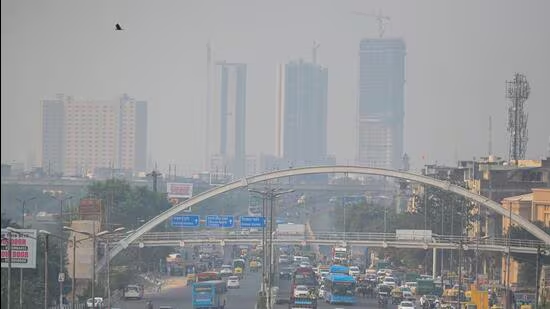Even in Delhi – a city that has earned grim global recognition for its pollution – Anand Vihar stands apart. While the Capital has long been a cautionary tale for pollution, this chaotic part of east Delhi has emerged as an even more polluted anomaly within the city.
Post-monsoon showers in the first half of October kept Delhi’s skies blue and the air quality index (AQI) between “satisfactory” and “moderate” levels, according to the Central Pollution Control Board (CPCB) data. But not in Anand Vihar.
On October 13, when Delhi’s average AQI was 189 (“moderate”), Anand Vihar’s monitor registered 346 – deep in the “very poor” zone. Over the next week, even as citywide levels crept from “moderate” to “poor,” Anand Vihar’s numbers hovered more than 100 points higher, sliding from “very poor” to “severe.”
Then on October 19, even before firecrackers began to dominate the city’s emission load, Anand Vihar’s AQI had soared to 423, marking its first foray into the “severe” level. In comparison, Delhi’s average AQI that day was 296.
On Diwali night, while Delhi’s AQI soared to 345 (“very poor”), the same figure in Anand Vihar was around 50 points higher (404, in the “severe” zone again).
Localised factors
An east Delhi pollution hub, being a melting pot of railway station, interstate bus terminal (ISBT), industrial roads and roads unfit to cater to its footfall, Anand Vihar comfortably experiences the worst-end of the pollution spectrum, experts said.
“You have the ISBT, the railway station and the metro station, which draws in a lot of passenger traffic and movement of buses. While some changes have been made over the years, more action is needed, particularly to manage congestion and movement of buses better,” said Sunil Dahiya, founder and lead analyst at the think-tank Envirocatalysts.
Dahiya dismissed the notion that the higher AQI was due to the continuous ambient air quality monitoring station (CAAQMS) being located adjacent to the ISBT, attributing higher pollution to other sources. “Road dust remains an issue and in particular, if there is construction being undertaken in the area. We also have some background emissions from industries operating on the UP side, not too far from here,” he said, calling for a localised plan which improves traffic management and cracks down on individual sources.
CPCB data showed Anand Vihar’s AQI was 404 (“severe”) on Diwali (October 20), 332 (“very poor”) on October 21, 390 (“very poor”) on October 22, and 410 (severe) on October 23.
This is likely to rise even further in the coming days, as meteorological conditions gradually worsen and mercury dips, leading to an accumulation of pollutants. While PM2.5 (particulate matter having a diameter of 2.5 microns or less) was the primary pollutant on October 21, indicating firecrackers were at play, PM10 has been the lead pollutant on every day since October 9, indicating dust in particular is impacting the air.
Real-time data from the Delhi Pollution Control Committee (DPCC) website showed high PM10 levels in the area, with the 24-hour average PM10 concentration shooting up to 655 micrograms per cubic metre (µg/m3) on Thursday, which is over six times the national standard of 100µg/m3. Since Diwali, the highest hourly peak was 1,824 µg/m3, logged at 2am on October 21.
Meanwhile, PM2.5 data was missing for the station between 11pm on October 20 and 10am on October 24 on the DPCC website. HT on October 21 reported how only nine of Delhi’s 39 stations had complete data for Diwali night and the day after, with the remaining stations all having gaps, including the one at Anand Vihar.
No quick remedy
Anand Vihar is among the 13 pollution hot spots identified jointly by the DPCC and CPCB in 2018, based on the annual PM2.5 concentration, which is higher than Delhi’s mean PM2.5. The other hot spots are Mundka, Wazirpur, Jahangirpuri, RK Puram, Rohini, Punjabi Bagh, Okhla, Bawana, Vivek Vihar, Narela, Ashok Vihar and Dwarka.
Anumita Roychowdhury, executive director, research and advocacy at the Centre for Science and Environment (CSE), said the area requires stringent source-based action to reduce the impact of localised pollution sources.
“Anand Vihar is a very complex land-use with diverse and concentrated polluting activities. The combined presence of ISBT, railway station, and metro station on one side and the Ghaziabad bus terminal across the border, lead to very high footfall and traffic movement. Heavy-duty traffic, buses and trucks, on National Highway 9 and NH 24 contribute substantially to pollution levels. This is further compounded by the emissions from the industrial areas of Sahibabad in Ghaziabad and the Patparganj in Delhi,” Roychowdhury said, adding that the Ghazipur landfill site nearby adds to the challenge.
Locals, meanwhile, said that despite assurances to regulate traffic, congestion continues to choke the area.
“The biggest contributor to pollution in the area is the ISBT and railway station. You have buses constantly moving or causing snarls. There is also an ISBT on the UP side which equally impacts the air here,” said Vinod Kumar, who is the RWA president of DDA flats in Anand Vihar.
Kumar said traffic has been particularly worse over the past couple of weeks, due to the festive rush. “Most trains for eastern India operate from Anand Vihar; so, there is a lot of rush for Chhath Puja,” Kumar said, stating there were multiple large-scale construction projects ongoing in the area too, including high-rises.
“All of these factors combine to make this a chaotic area, full of dust and vehicular emissions,” Kumar said, adding most residents had been coughing non-stop this past week.
Images are for reference only.Images and contents gathered automatic from google or 3rd party sources.All rights on the images and contents are with their legal original owners.
